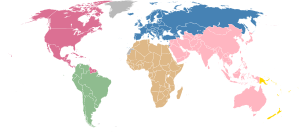Copa Libertadores Da América
The competition has had several formats over its lifetime. Initially, only the champions of the South American leagues participated. In 1966, the runners-up of the South American leagues began to join. In 1998, Mexican teams were invited to compete and contested regularly from 2000 until 2016. In 2000 the tournament was expanded from 20 to 32 teams. Today at least four clubs per country compete in the tournament, with Argentina and Brazil having the most representatives (six and seven clubs, respectively). A group stage has always been used but the number of teams per group has varied.
In the present format, the tournament consists of eight stages, with the first stage taking place in late January. The four surviving teams from the first three stages join 28 teams in the group stage, which consists of eight groups of four teams each. The eight group winners and eight runners-up enter the knockout stages, which end with the final in November. The winner of the Copa Libertadores becomes eligible to play in the FIFA Club World Cup, FIFA Intercontinental Cup and the Recopa Sudamericana.
Independiente of Argentina is the most successful club in the cup's history, having won the tournament seven times. Argentine clubs have accumulated the most victories with 25 wins, while Brazil has the largest number of winning teams, with 12 clubs having won the title. The cup has been won by 27 clubs, 15 of them have done it more than once, and seven clubs have won two years in a row.
History
The clashes for the Copa Aldao between the champions of Argentina and Uruguay kindled the idea of continental competition in the 1930s. In 1948, the South American Championship of Champions (Spanish: Campeonato Sudamericano de Campeones), the most direct precursor to the Copa Libertadores, was played and organized by the Chilean club Colo-Colo after years of planning and organization. Held in Santiago, it brought together the champions of each nation's top national leagues. The tournament was won by Vasco da Gama of Brazil. The 1948 South American tournament began, in continent-wide reach, the "champions cup" model, resulting in the creation of the European Cup in 1955, as confirmed by Jacques Ferran (one of the "founding fathers" of the European Cup), in a 2015 interview with a Brazilian TV sports programme.
In 1958, the basis and format of the competition were created by Peñarol's board leaders. On October 8, 1958, João Havelange announced, at a UEFA meeting he attended as an invitee, the creation of Copa de Campeones de America (American Champions Cup, renamed in 1965 as Copa Libertadores), as a South American equivalent of the European Cup, so that the champion clubs of both continental confederations could decide "the best club team of the world" in the Intercontinental Cup. On March 5, 1959, at the 24th South American Congress held in Buenos Aires, the competition was ratified by the International Affairs Committee. In 1965, it was named in honor of the heroes of South American liberation, such as Simón Bolívar, José de San Martín, Pedro I, Bernardo O'Higgins, and José Gervasio Artigas, among others.
Format
Qualification
Most teams qualify for the Copa Libertadores by winning half-year tournaments called the Apertura and Clausura tournaments or by finishing among the top teams in their championship. The countries that use this format are Bolivia, Colombia, Ecuador, Paraguay, Peru, Uruguay and Venezuela. Peru and Ecuador have developed new formats for qualification to the Copa Libertadores involving several stages. Argentina, Brazil and Chile are the only South American leagues to use a European league format instead of the Apertura and Clausura format. However, one berth for the Copa Libertadores can be won by winning the domestic cups in these countries.
Peru, Uruguay and Mexico formerly used a second tournament to decide qualification for the Libertadores (the "Liguilla Pre-Libertadores" between 1992 and 1997, the "Liguilla Pre-Libertadores de América" from 1974 to 2009, and the InterLiga from 2004 to 2010, respectively). Argentina used an analogous method only once in 1992. Since 2011, the winner of the Copa Sudamericana has qualified automatically for the following Copa Libertadores.
For the 2019 edition, the different stages of the competition were contested by the following teams:
| First stage | ||
|---|---|---|
| ||
| Second stage | ||
| ||
| Third stage | ||
| ||
| Group stage | ||
| ||
| Final stages | ||
|
| Country | First Stage | Second Stage | Group Stage |
|---|---|---|---|
| Brazil | 2 | 5 | |
| Argentina | 1 | 5 | |
| Chile | 2 | 2 | |
| Colombia | 2 | 2 | |
| Bolivia | 1 | 1 | 2 |
| Ecuador | 1 | 1 | 2 |
| Paraguay | 1 | 1 | 2 |
| Peru | 1 | 1 | 2 |
| Uruguay | 1 | 1 | 2 |
| Venezuela | 1 | 1 | 2 |
The winners of the previous season's Copa Libertadores are given an additional entry to the group stage even if they do not qualify for the tournament through their domestic performance; however, if the title holders qualify for the tournament through their domestic performance, an additional entry is granted to the next eligible team, "replacing" the titleholder.

